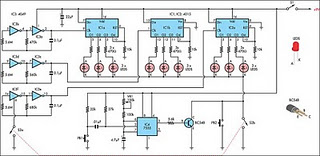Home » Circuits
Quick Counter For Young Children
This circuit is a toy to encourage young children to count. Power is turned on by switch S1, then S2 is closed. This makes nine LEDs flash slowly. S2 is then opened and the LEDs go out. Pressing pushbutton PB1 turns on a random number of LEDs - briefly - during which time they are to be counted. The number counted can be checked by pressing PB2 which turns the same LEDs on for as long as needed. Then repeat. The circuit works as follows: IC3 is a 4049 hex inverter connected as three oscillators running at different rates. It is turned on by closing switch S2a. The clock pulses from IC3 drive both halves of IC1 and one half of IC2, both being 4015 dual 4-stage shift registers. Each shift register has four outputs which go high in order: 1, 1 and 2; 1 and 2 and 3; 1 and 2 and 3 and 4. However as output 4 is connected to the reset line of its own half - the shift register resets to zero. Outputs 1, 2 & 3 of all three shift registers are connected to nine LEDs, the cathodes of which go to a common rail.Circuit diagram:

This rail is connected to ground via S2b when switch S2 is closed. When S2 is opened the three oscillators stop but a random number of LEDs is still connected to the high outputs of the 4015s. That number can be viewed briefly by pressing PB1 which pulses the 7555 timer in monostable mode, to give a short duration output which drives Q1 and connects the LED cathodes to 0V. The viewing time is adjustable by VR1. Checking a count is done by pressing PB2 which holds the same LEDs on as long as desired. The LEDs are set in a 3 x 3 grid with the connection scattered, ie, the first row is not the three LEDs from the first half of IC1. Note that, unlike the usual dice, a number such as 5 can appear in many formats, so pattern recognition is no help. Also note that this is not a nine output true dice - because the numbers do not come up with equal frequency.
Author: A. Lowe - Copyright: Silicon Chip
